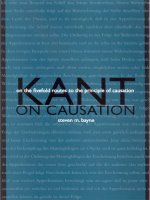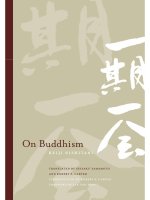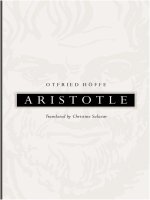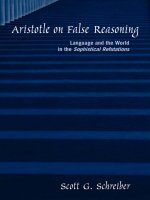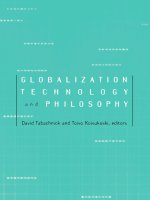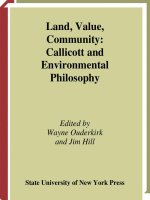state university of new york press heideggers neglect of the body sep 2009
Bạn đang xem bản rút gọn của tài liệu. Xem và tải ngay bản đầy đủ của tài liệu tại đây (575.61 KB, 195 trang )
Heidegger’s Neglect
of the Body
SUNY series in Contemporary Continential Philosophy
Dennis J. Schmidt, editor
Heidegger’s Neglect
of the Body
Kevin A. Aho
Published by
State University of New York Press, Albany
© 2009 State University of New York
All rights reserved
Printed in the United States of America
No part of this book may be used or reproduced in any manner whatsoever
without written permission. No part of this book may be stored in a
retrieval system or transmitted in any form or by any means including
electronic, electrostatic, magnetic tape, mechanical, photocopying, recording,
or otherwise without the prior permission in writing of the publisher.
For information, contact State University of New York Press, Albany, NY
www.sunypress.edu
Production by Diane Ganeles
Marketing by Michael Campochiaro
Library of Congress Cataloging-in-Publication Data
Aho, Kevin, 1969-
Heidegger’s neglect of the body / Kevin A. Aho.
p. cm.
Includes bibliographical references and index.
ISBN 978-1-4384-2775-1 (hardcover : alk. paper)
1. Heidegger, Martin, 1889–1976. 2. Body, Human (Philosophy)
I. Title.
B3279.H49A39 2009
128'.6092—dc22 2008050717
10 9 8 7 6 5 4 3 2 1
For Charles Guignon
Acknowledgments ix
Abbreviations xi
Introduction 1
The Body Problem 1
Chapter Overview 4
Chapter 1 Heidegger’s Project 7
Dismantling Cartesian Metaphysics 9
Dasein and Everydayness 11
Temporality as the Meaning of Being 22
Chapter 2 The Missing Dialogue between Heidegger
and Merleau-Ponty 29
The Absence of the Body in Being and Time 29
The Body and the Problem of Spatiality 33
The Importance of the Zollikon Seminars 36
The Limits of Merleau-Ponty’s Relation to Heidegger 43
Chapter 3 Gender and Time: On the Question of
Dasein’s Neutrality 53
Fundamental Ontology and the Sex/Gender Divide 53
Gendered Dasein and Neutral Da-sein 55
The Gender and Neutrality of Time 61
Chapter 4 Life, Logos, and the Poverty of Animals 73
Dasein’s Animal-Nature 74
The Question of Life in the Aristotle Lectures 79
Logos and the Animal Question 87
The Animal Lectures in Context 96
Prelude to a Theory of Embodiment 100
viii
Contents
Chapter 5 The Accelerated Body 105
Technological Existence 106
Acceleration and Boredom 113
Acceleration and Psychotherapy 119
Chapter 6 Recovering Play: On Authenticity and Dwelling 127
Technology and Authentic Historicality 128
Leisure and Openness to Mystery 132
Conclusion: Embodied Dwelling 143
Notes 151
Index 169
ix
Acknowledgments
This project would not have been completed without the loving sup-
port of my beautiful wife, Elena. She, my parents, Jim and Margaret
Aho, and my brothers, Ken and Kyle, have been a continual source
of strength, inspiration, and joy. To my teachers at the University
of South Florida, where this project was originally conceived, I am
thankful to Stephen Turner, Ofelia Schutte, and Joanne Waugh. For
their careful reading and recommendations, I am thankful to Hans
Pedersen and Bill Koch. I am also deeply appreciative of my sup-
portive colleagues at Florida Gulf Coast University, especially Sean
Kelly, Kim Jackson, Glenn Whitehouse, Maria Roca, Jim Wohlpart,
Karen Tolchin, and Tom Demarchi. Most of all, I am indebted to my
teacher and dear friend, Charles Guignon. His intellectual guidance,
encouragement, and wonderful sense of humor over the years kept
this project going. His friendship has been a gift in my life, and this
book is dedicated to him.
I would also like to thank the editors and publishers of the
following journals for permission to reprint portions of the following
articles:
“Metontology and the Body-Problem in Being and Time.” Auslegung
28:2 (2006): 1–20. Peter Montecuollo, ed. (ch. 1).
“The Missing Dialogue between Heidegger and Merleau-Ponty:
On the Importance of the Zollikon Seminars.” Body and Society 11:2
(2005): 1–2. Mike Featherstone and Bryan Turner, eds. (ch. 2).
“Gender and Time: Revisiting the Question of Dasein’s Neutrality.”
Epoché 12:1 (2007): 137–155. Walter Brogan, ed. (ch. 3).
“Animality Revisited: The Question of Life in Heidegger’s Early
Freiburg Lectures.” Existentia 16: 5–6 (2006): 379–392. Gábor Ferge,
ed. (ch. 4).
“Logos and the Poverty of Animals: Rethinking Heidegger’s
Humanism.” The New Yearbook for Phenomenology and Phenomenological
Philosophy 7 (2007): 109–126. Steven Crowell and Burt Hopkins, eds.
(ch. 4).
“Simmel on Acceleration, Boredom, and Extreme Aesthesia.”
Journal for the Theory of Social Behavior 37:4 (2007): 447–462. Charles
Smith, ed. (ch. 5).
“Acceleration and Time Pathologies: The Critique of Psychology
in Heidegger’s Beiträge.” Time and Society 16:1 (2007): 25–42. Robert
Hassan, ed. (ch. 5).
“Recovering Play: On the Relationship between Leisure and
Authenticity in Heidegger’s Thought.” Janus Head 10:1 (2007): 217–238.
Brent Robbins, ed. (ch. 6).
For permission to reprint a selection from Thich Nhat Hanh I am
grateful to Parallax Press for the excerpt from The Heart of Understanding:
Commentaries on the Prajñaparamita Heart Sutra, by Thich Nhat Hanh
(Berkeley, CA: Parallax Press, 1988), www.parallax.org.
x
Acknowledgments
Abbreviations
Works by Heidegger
“GA” indicates the volume of the Gesamtausgabe (Collected Works).
Frankfurt am Main: Vittorio Klostermann. The lecture/publication date
follows the German title. Unless otherwise indicated, all references are
from the English translation and pagination.
AWP Die Zeit des Weltbildes. 1938. (GA 5). “The Age of the World
Picture.” In The Question Concerning Technology and Other Essays,
trans. William Lovitt. New York: Harper and Row, 1977.
BDT Bauen Wohnen Denken. 1951. (GA 7). “Building Dwelling Think-
ing.” In Basic Writings, trans. Albert Hofstadter. New York:
HarperCollins, 1993.
BP Die Grundprobleme der Phänomenologie. 1927. (GA 24). The Basic
Problems of Phenomenology. Translated by Albert Hofstadter.
Bloomington: Indiana University Press, 1982.
BQP Grundfragen der Philosophie: Ausgewählte “Probleme” der “Logik.”
1937. (GA 45). Basic Questions of Philosophy: Selected “Problems”
of “Logic.” Translated by Richard Rojcewicz and André Shuwer.
Bloomington: Indiana University Press, 1994.
BT Sein und Zeit. 1927. (GA 2). Being and Time. Translated by John
Macquarrie and Edward Robinson. New York: Harper and
Row, 1978.
CP Beiträge zur Philosophie (Vom Ereignis). 1936–1938. (GA 65). Con-
tributions to Philosophy (From Enowning). Translated by Parvis
Emad and Kenneth Maly. Bloomington: Indiana University
Press, 1999.
CT Der Begriff der Zeit. 1924. (GA 64). The Concept of Time. Trans-
lated by William McNeill. Oxford: Blackwell, 1992.
xi
DHW Wilhelm Diltheys Forschungsarbeit und der Kampf um eine his-
torische Weltanschauung. 1925. (GA 80). “Wilhelm Dilthey’s
Research and the Struggle for a Historical Worldview.” In
Supplements: From the Earliest Essays to Being and Time and
Beyond, trans. Charles Bambach. Albany: State University of
New York Press, 2002.
DT Gelassenheit. 1955. (GA 16). “Memorial Address.” In Discourse
on Thinking, trans. John Anderson and E. Hans Freund. New
York: Harper and Row, 1966.
ET Vom Wesen der Wahrheit. 1930. (GA 9). “On the Essence of Truth.”
In Basic Writing, trans. John Sallis. New York: HarperCollins,
1993.
FCM Die Grundbegriffe der Metaphysik: Welt, Endlichkeit, Einsamkeit.
1929–1930. (GA 29/30). Fundamental Concepts of Metaphysics:
World, Finitude, Solitude. Translated by William McNeill and
Nicholas Walker. Bloomington: Indiana University Press,
1995.
FS Seminare—Zähringen. 1973. (GA 15). “Seminar in Zähringen.”
In Four Seminars, trans. Andrew Mitchell and François Raffoul.
Bloomington: Indiana University Press, 2003.
HCT Prolegomena zur Geschichte des Zeitbegriffs. 1925. (GA 20). His-
tory of the Concept of Time: Prolegomena. Translated by Theodore
Kisiel. Bloomington: Indiana University Press, 1985.
HF Ontologie: Hermeneutik der Faktizität. 1923. (GA 63). Ontology:
The Hermeneutics of Facticity. Translated by John van Buren.
Bloomington: Indiana University Press, 1999.
HS Seminare—Heraklit. 1966–1967. (GA 15). Heraclitus Seminar,
1966/67 (with Eugen Fink). Translated by Charles H. Seibert.
Evanston, IL: Northwestern University Press, 1993.
IM Einführung in die Metaphysik. 1935. (GA 40). Introduction to
Metaphysics. Translated by Gregory Fried and Richard Polt.
New Haven, CT: Yale University Press, 2000.
IP Einleitung in die Philosophy. 1928–1929. (GA 27). Introduction to
Philosophy. Translation in preparation. References are from the
German pagination. Frankfurt am Main: Vittorio Klostermann,
1996.
KPM Kant und das Problem der Metaphysik. 1929. (GA 3). Kant and the
Problem of Metaphysics. Translated by Richard Taft. Bloomington:
Indiana University Press, 1997.
xii
Abbreviations
xiii
Abbreviations
LA Die Sprache. 1950. (GA 12). “Language.” In Poetry, Language,
Thought, trans. Albert Hofstadter. New York: Harper and Row,
1971.
LH Brief über den Humanismus. 1947. (GA 9). “Letter on Human-
ism.” In Basic Writings, trans. Frank Capuzzi and J. Glenn
Gray. New York: HarperCollins 1993.
LS Logos (Heraklit, Fragment 50). 1951. (GA 7). “Logos (Heraclitus,
Fragment B 50).” In Early Greek Thinking, trans. David F. Krell
and Frank A. Capuzzi. New York: Harper and Row, 1975.
MFL Metaphysische Anfangsgründe der Logik im Ausgang von Leibniz.
1928. (GA 26). Metaphysical Foundations of Logic. Translated by
Michael Heim. Bloomington: Indiana University Press, 1984.
N1 Der Wille zur Macht als Kunst. 1936–1937. (GA 6). “The Will to
Power as Art.” In Nietzsche Vol. 1, trans. David F. Krell. New
York: Harper and Row, 1979.
N2 Die ewige Wiederkehr des Gleichen. 1937. (GA 6). “The Eternal
Recurrence of the Same.” In Nietzsche Vol. II, trans. David F.
Krell. New York: Harper and Row, 1984.
N3 Der Wille zur Macht als Erkenntnis. 1939. (GA 6). “The Will to
Power as Knowledge and as Metaphysics.” In Nietzsche Vol. III,
trans. Joan Stambaugh, David F. Krell, and Frank A. Capuzzi.
New York: Harper and Row, 1984.
N4 Der europäische Nihilismus. 1940. (GA 6). “European Nihilism.”
In Nietzsche Vol. IV, trans. Frank A. Capuzzi. New York: Harper
and Row, 1982.
NL Das Wesen der Sprache. 1957. (GA 12). “The Nature of Language.”
In On the Way to Language, trans. Peter D. Hertz. New York:
Harper and Row, 1971.
OH Hölderlins Hymnen “Wie wenn am Feiertage . . .” 1941. (GA 4).
“Hölderlin’s Hymn ‘As When On Holiday . . .’ ” In Elucida-
tions of Hölderlin’s Poetry, trans. Keith Hoeller. Amherst, NY:
Humanity Books, 2000.
OTB Zeit und Sein. 1962. (GA 14). On Time and Being. Translated by
Joan Stambaugh. New York: Harper and Row, 1972.
OWA Der Ursprung des Kunstwerkes. 1935. (GA 5). “The Origin of
the Work of Art.” In Basic Writings, trans. Albert Hofstadter.
New
York: HarperCollins, 1993.
PA Phänomenologische Interpretationen zu Aristoteles: Einführung in
die phänomenologische Forschung. 1921. (GA 61). Phenomeno-
logical Interpretations of Aristotle: Initiation into Phenomenologi-
cal Research. Translated by Richard Rojcewicz. Bloomington:
Indiana University Press, 2001.
PS Platon: Sophistes. 1924–1925. (GA 19). Plato’s Sophist. Translated
by Richard Rojcewicz and André Schuwer. Bloomington: Indi-
ana University Press, 2003.
QCT Die Frage nach der Technik. 1949. (GA 7). “The Question Con-
cerning Technology.” In The Question Concerning Technology
and Other Essays, trans. William Lovitt. New York: Harper and
Row, 1977.
RE Hölderlins Hymnen “Andenken.” 1943. (GA 4). “Hölderlin’s
Hymn ‘Remembrance.’ ” In Elucidations of Hölderlin’s Poetry,
trans. Keith Holler. Amherst, NY: Humanity Books, 2000.
TDP Zur Bestimmung der Philosophie. 1919. (GA 56/57). Towards the
Defi nition of Philosophy. Translated by Ted Sadler. London:
Continuum Books, 2002.
TT Das Ding. 1951. (GA 7). “The Thing.” In Poetry, Language,
Thought, trans. Albert Hofstadter. New York: Harper and Row,
1971.
TU Die Kehre. 1949. (GA 79). “The Turning.” In The Question Con-
cerning Technology and Other Essays, trans. William Lovitt. New
York: Harper and Row, 1977.
WCT Was heisst Denken? 1951–1952. (GA 8). What Is Called Thinking?
Translated by J. Glenn Gray. New York: Harper and Row,
1968.
WIT Die Frage nach dem Ding. 1935. (GA 41). What Is a Thing?
Translated by W. B. Barton and Vera Deutsch. South Bend,
IN: Regenery/Gateway, 1967.
WL Der Weg zur Sprache. 1959. (GA 12). “The Way of Language.”
In On the Way to Language, trans. Peter D. Hertz. New York:
HarperCollins, 1971.
ZS Zollikoner Seminare. 1959–1972. (GA 89). Zollikon Seminars.
Translated by Franz Mayr and Richard Askey. Evanston, IL:
Northwestern University Press, 2001.
xiv
Abbreviations
xv
Abbreviations
Works by Jacques Derrida
G1 “Geschlecht: Sexual Difference, Ontological Difference.” In
Feminist Interpretations of Martin Heidegger, ed. Nancy J. Hol-
land and Patricia Huntington. University Park: Pennsylvania
State University Press, 2001.
G2 “Geschlecht II: Heidegger’s Hand.” In Deconstruction and Phi-
losophy: The Texts of Jacques Derrida, ed. John Sallis, trans. John
P. Leavey Jr. Chicago, IL: University of Chicago Press, 1987.
MP Margins of Philosophy. Translated by Alan Bass. Chicago, IL:
University of Chicago Press, 1982.
OS Of Spirit: Heidegger and the Question. Translated by Geoffrey
Bennington and Rachel Bowlby. Chicago, IL: University of
Chicago Press, 1989.
Works by Luce Irigaray
JTN je, tu, nous: Toward a Culture of Difference. Translated by Alison
Martin. New York: Routledge Press, 1993.
SG Sexes and Geneologies. Translated by Gillian C. Gill. New York:
Columbia University Press, 1993.
SWN The Sex Which Is Not One. Translated by Gillian C. Gill. Ithaca,
NY: Cornell University Press, 1985.
Works by Maurice Merleau-Ponty
PP Phenomenology of Perception. Translated by Colin Smith. New
York: Routledge, 1962.
VI The Visible and the Invisible, Followed by Working Notes. Translated
by Alphonso Lingis. Evanston, IL: Northwestern University
Press, 1968.
Introduction
The Body Problem
It has been over fi fty years since French philosophers began criticizing
the “starting-point” (Ausgang) of Being and Time (1927)—specifi cally
Heidegger’s account of everyday practices, practices that initially give
us “access” (Zugang) to the question of the meaning of being. Alphonse
de Waelhens, for example, argued that Heidegger’s phenomenology
completely overlooks the fundamental role played by perception in
particular and the body in general in our everyday understanding
of things. “[In] Being and Time,” says Waelhens, “one does not fi nd
thirty lines concerning the problem of perception; one does not fi nd
ten concerning that of the body.”
1
Jean-Paul Sartre amplifi ed this line
of criticism when he emphasized the importance of the body as the
fi rst point of contact that a human being has with its world, a contact
that is prior to detached theorizing about objects.
Of the early French phenomenologists, Maurice Merleau-Ponty’s
work has been the most infl uential. He laid the foundations for a
critique of Heidegger through his systematic analysis of the primacy
of bodily perception, particularly in terms of our spatial directionality
and orientation, a sensual orientation that makes it possible for us to
handle worldly equipment in the fi rst place.
2
Merleau-Ponty’s account
of embodiment has since been developed and refi ned by English-
speaking commentators such as Hubert Dreyfus, David Cerbone, and
David Krell.
3
Krell formulates the problem this way:
Did Heidegger simply fail to see the arm of the everyday
body rising in order to hammer the shingles onto the roof,
did he overlook the quotidian gaze directed toward the
ticking watch that overtakes both sun and moon, did he
miss the body poised daily in its brazen car, a car equipped
with a turn signal fabricated by and for the hand and eye
1
2
Heidegger’s Neglect of the Body
of man, did he neglect the human being capable day-in and
day-out of moving its body and setting itself in motion? If
so, what conclusion must we draw?
4
In Being and Time there is little acknowledgment of the “lived-body”
(Leib) that prerefl ectively negotiates its way through the world, a body
that is already spatially oriented in terms of directionality as it reaches
out and faces the various tools and others that are encountered every
day.
5
Heidegger merely offers this remark:
Dasein’s spatialization in its “bodily nature” is likewise
marked out in accordance with these directions. [This
“bodily nature” hides a whole problematic of its own,
though we shall not treat it here.] (BT, 143)
This Merleau-Pontyian criticism has been recently fortifi ed by femi-
nist critics following the 1983 publication of Jacques Derrida’s essay
“Geschlecht: Sexual Difference, Ontological Difference.” His essay
helped pave the way for two decades of commentary, which attempts
to enrich Heidegger’s project by addressing the possibility of a gen-
dered incarnation of human existence (Dasein). For Heidegger—spe-
cifi cally in his 1928 Marburg lectures on Leibniz—Dasein is regarded
as “neutral” (neutrale) or “asexual” (geschlechtslos) insofar as it exists
prior to and makes possible an understanding of sexed bodies and
gendered practices. This position has left many feminist commenta-
tors dissatisfi ed. If one of the goals of Heidegger’s early project is
to recover concrete, embodied ways of being, ways of being that are
more original than disembodied theorizing, then Heidegger would
do well to acknowledge the ways in which these concrete practices
are shaped and guided by sexual difference. By giving an account of
Dasein’s gendered incarnation, Heidegger’s analysis of human exis-
tence would have recognized the social hierarchies and oppressive
relations that already exist in our everyday dealings. This recognition
would have allowed for a more complete picture of the way in which
human beings dwell in an understanding of being.
In addition to these feminist criticisms, there has been a recent
explosion of commentary in the secondary literature that addresses
Heidegger’s account of the relationship between humans and animals,
particularly in his 1929–1930 Freiburg lecture course “The Fundamen-
tal Concepts of Metaphysics.”
6
In these lectures, Heidegger appears
to perpetuate the oppositional prejudices of traditional humanism by
arguing that there is a fundamental difference between animal “behav-
3
Introduction
ior” (Benehmen) and human “comportment” (Verhalten). This difference,
according to Heidegger, leaves nature in the domain of “unmeaning”
(unsinniges) and animals without an understanding of being. As a result,
animals are regarded as impoverished or “poor in world” (weltarm),
while human practices are always meaningful and “world-forming (welt-
bildend). A number of critics have argued that Heidegger’s conception
of Dasein needs to be expanded to include the body that is organically
connected to nature and to the most primitive forms of life. Based on
this view, our embodied interconnectedness to animals is regarded as
fundamental to the way we make sense of things.
What these criticisms tend to suggest is that Heidegger’s proj-
ect is missing an explicit recognition of how the body participates
in shaping our everyday understanding of things. Indeed, if one of
Heidegger’s core motivations is to reveal how beings “always already”
(immer schon) make sense to us in the course of everyday life, then it
appears that the body should be interpreted as—in the language of
Being and Time—an “existentiale” (Existenzial), an essential structure or
condition for any instance of Dasein. David Cerbone explains, “The
body would seem to be immediately implicated in [Heidegger’s]
phenomenology of everyday activity. . . . For this activity involves the
manipulation of concrete items such as hammers, pens, doorknobs,
and the like, and those manipulations are effected by means of the
body.”
7
While acknowledging the merits of these criticisms, the goal
of this book is to address the question of why Heidegger may have
bypassed an analysis of the body in the fi rst place and where such an
analysis might fi t within the overall context of his project.
In the following, I suggest that the criticisms of Heidegger regard-
ing his neglect of the body hinge largely on a misinterpretation of
Heidegger’s use of the word “Dasein.” For Heidegger, Dasein is not
to be understood in terms of everyday human existence or embodied
agency but—from his earliest Freiburg lectures onward—as an unfold-
ing historical horizon or space of meaning that is already “there” (Da),
prior to the emergence of the human body and its various capacities.
Heidegger reminds us of this point thirty years after the publication
of Being and Time in his seminars in Zollikon:
The Da in Being and Time does not mean a statement of
place for a being, but rather it should designate the open-
ness where beings can be present for the human being,
and the human being also for himself. The Da of [Dasein’s]
being distinguishes the humanness of the human being.
(ZS, 120)
4
Heidegger’s Neglect of the Body
I argue that it is only on the basis of an already opened horizon of
meaning that we can understand and make sense of beings in the
fi rst place, including the “corporeal body” (Körper), the “lived-body”
(Leib), and all of its manifestations. This, however, does not mean that
Heidegger dismisses the value of phenomenological investigations of
the body, but that such investigations are not crucial to his program
of “fundamental ontology.” Indeed, in Being and Time, Heidegger pro-
poses that the phenomena of the “body,” “life,” and “consciousness”
are all areas of regional inquiry that are worthy of phenomenological
investigation in their own right, but such investigations are rendered
intelligible only on the basis of Dasein (BT, 143, 75, 151). In this regard,
fundamental ontology—understood as the inquiry into the meaning of
being in general—is more original than any analysis of the body.
Before moving on, it is important to acknowledge that Hei-
degger appeared to be genuinely troubled by his own inability to
address the body problem, particularly in his early writings. Although
Heidegger recognized the importance of the spatial directionality of
the body in Being and Time and continued to engage the problem of
embodiment in his 1929–1930 lectures on animals and biology, in his
Nietzsche lectures of 1936–1937, in his 1947 “Letter on Humanism,”
and especially in his decade-long seminars in Zollikon from 1959 to
1971, toward the end of his career he began to recognize that the topic
of embodiment presented special diffi culties that he was simply not
equipped to deal with. In his Heraclitus seminars of 1966–1967, he
referred to the body as “the most diffi cult problem” (HS, 147), and
in 1972 he makes his most revealing remark, admitting that he was
unable to respond to earlier French criticism regarding the neglect of
the body in Being and Time, because “the bodily [das Leibliche] is the
most diffi cult [problem to understand] and I was unable to say more
at the time” (ZS, 231).
Chapter Overview
Chapter 1, “Heidegger’s Project,” offers a brief introduction to Hei-
degger’s early project, introduces core concepts that will be revisited
throughout this book, and identifi es themes that reveal a consistency
and cohesion to Heidegger’s thought throughout his career. Chap-
ters 2, 3, and 4 address the core criticisms of the body problem in
the secondary Heidegger literature. Chapter 2, “The Missing Dia-
logue between Heidegger and Merleau-Ponty,” offers an account of
the Merleau-Pontyian criticism and provides a detailed analysis of
5
Introduction
Heidegger’s Zollikon seminars, which explicitly engage the body
problem in a way that overlaps signifi cantly with the phenomenology
of Merleau-Ponty. Chapter 3, “Gender and Time: On the Question of
Dasein’s Neutrality,” addresses recent feminist criticisms that chal-
lenge Heidegger’s claim of Dasein’s sexual neutrality by indicating
the ways in which our everyday understanding of things is already
colored by sexual difference. Chapter 4, “Life, Logos, and the Poverty
of Animals,” addresses the work of a growing number of critics who
have questioned Heidegger for downplaying our bodily kinship with
animals, portraying animals as impoverished, or “world-poor,” and
humans as “world-forming.”
After situating the body problem within the context of Hei-
degger’s overall project, I hope to show that Heidegger—though
rarely discussing the body itself—nonetheless makes a signifi cant
contribution to theories of embodiment. This is evident not only in
his familiar discussions of our engagement with “handy” (zuhanden)
tools but especially in his groundbreaking analysis of moods, most
notably the pervasive cultural affects of anxiety and boredom that are
symptomatic of modern life. In light of these contributions, chapter
5, “The Accelerated Body,” examines Heidegger’s notion of “accelera-
tion” (Beschleunigung), introduced in his Contributions to Philosophy
(1936–1938), as one of the three symptoms—along with “calculation”
and the “outbreak of massiveness”—that characterizes our technologi-
cal existence. In this chapter, I unpack the relationship between these
symptoms and explore the ways in which they form and de-form the
body. By supplementing Heidegger’s insights with recent fi ndings
in social psychology, I suggest that the body is becoming increas-
ingly fragmented and emotionally overwhelmed from chronic sensory
arousal and time pressure. This experience not only damages the body
physiologically, but it makes it increasingly diffi cult to qualitatively
distinguish what matters to us in our everyday lives, resulting in what
Heidegger calls “deep boredom” (tiefe Langeweile) (FCM, 134).
Chapter 6, “Recovering Play: On Authenticity and Dwelling,”
expands on the problem of the accelerated body by attempting to
reconcile two confl icting accounts of authenticity in Heidegger’s
thought. Authenticity in Being and Time is commonly interpreted
in “existentialist” terms as willful commitment and “resoluteness”
(Entschlossenheit) in the face of one’s own death, but by the late 1930s,
it is reintroduced, in terms of Gelassenheit, as a nonwillful openness that
“lets beings be.” By employing Heidegger’s conception of authentic
“historicality” (Geschichtlichkeit), understood as the retrieval of Dasein’s
past, I suggest that the ancient interpretation of leisure and festivity
6
Heidegger’s Neglect of the Body
may play an important role in unifying these confl icting accounts.
Genuine leisure, interpreted as a form of “play” (Spiel), frees us from
technological busy-ness and gives us an opening to face the abyssal
nature of our own being and the mystery that “beings are” in the
fi rst place. To this end, leisure reconnects us to the original Greek
temperament of “wonder” (Erstaunen), an embodied disposition that
does not seek accelerated mastery and control over beings but calmly
accepts the unsettledness of being and is, as a result, allowed into the
original openness or play of “time-space” (Zeit-Raum) that lets beings
emerge-into-presence on their own terms.
Although it critically engages the various manifestations of the
body problem in the secondary literature and offers ways to fruitfully
appropriate a theory of embodiment from Heidegger, the central aim
of this book is to show that Heidegger was not, at bottom, interested
in giving an account of embodied agency. It is true that he begins
his analytic of Dasein with descriptions of concrete, practical activity,
but these descriptions are important only insofar as they “point to”
or “indicate” (anzeigen) structures that open up a space or “clearing”
(Lichtung) of meaning, which makes possible any interpretation or
understanding of beings. Thus the core motivation of Heidegger’s
project is not to offer phenomenological investigations into everyday
life but to inquire into the meaning of being itself. And this inquiry
ultimately leads us beyond the question of embodied agency to the
structures of meaning itself. For Heidegger, it is only on the basis of
these structures that we can begin to make sense of things—such as
bodies—in the fi rst place.
1
Heidegger’s Project
In his 1935 summer semester lecture course at the University of
Freiburg, entitled “Introduction to Metaphysics,” Heidegger asks a
seemingly innocuous question: “How does it stand with being?,” or,
translated in a colloquial sense: “How’s it going with being?” (IM,
41)
1
The answer is: not well. Today, humankind is consumed by an
instrumental relationship with beings; we have closed off other world-
views, forcing all beings—including humans—to show up or reveal
themselves in only one way, as objects to be effi ciently manipulated
and controlled. The prognosis, according to Heidegger, is bleak. In an
oft-quoted passage from these lectures, he gives his assessment:
The spiritual decline of the earth has progressed so far that
people are in danger of losing their last spiritual strength,
the strength that makes it possible even to see the decline
and to appraise it as such. This simple observation has
nothing to do with cultural pessimism—nor with any opti-
mism either, of course; for the darkening of the world, the
fl ight of the gods, the destruction of the earth, the reduc-
tion of human beings into a mass, the hatred and mistrust
of everything creative and free has already reached such
proportions throughout the whole earth that such childish
categories as pessimism and optimism have become laugh-
able. (IM, 40–41)
Heidegger refers to this modern predicament as “nihilism.” Nihil-
ism shows itself when the “question of being” (Seinsfrage) is forgotten
and humankind is concerned with the world only as a vast storehouse
of beings to be used. Nihilism, on this view, is the “spiritual decline of
the earth,” where human beings “have long since fallen out of being,
without knowing it” (IM, 39). The culprit for this spiritual decline is
the metaphysical worldview itself.
7


